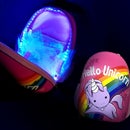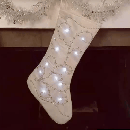Introduction: Lightwings: Fiber Optic Fairy Wings
Add some glamour to your fairy costume using fiber optics.
This method for light up wings uses a simple circuit of LEDs and a battery to achieve a look a similar to EL wire, but thinner and almost invisible when not lit up. The lighting isn't as even as EL wire because it uses a single light source instead of glowing along its length, but it was an interesting and fun experiment.
It would be pretty easy to advance the project by hooking the LEDs up to a LilyPad to create blinking or fading light effects as well.
This method for light up wings uses a simple circuit of LEDs and a battery to achieve a look a similar to EL wire, but thinner and almost invisible when not lit up. The lighting isn't as even as EL wire because it uses a single light source instead of glowing along its length, but it was an interesting and fun experiment.
It would be pretty easy to advance the project by hooking the LEDs up to a LilyPad to create blinking or fading light effects as well.
Step 1: Materials
Materials:
* Fairy wings (store bought or handmade), with any decoration removed from the middle/center of the wing frame
* Sparkle Fiber Optic Cable - a specialty fiber optic that lights up along the length of the cable, choose the kind with 6 strands. The amount will depend on how large your wings are: in this example I used ~4 ft.
* Sewable Coin Cell Battery Holder
* 3V CR2032 Coin Cell Battery
* (2) 5mm or 3mm LEDs - super brights work best for a dramatic effect
* Conductive Thread
* Needle and Cotton Thread
* Felt
* Hot Glue Gun & Glue
* Electrical Tape
* Masking Tape (optional)
* Scissors
* Pliers
* Pen/Pencil
* Velcro
* Cardboard/Posterboard
* Fairy wings (store bought or handmade), with any decoration removed from the middle/center of the wing frame
* Sparkle Fiber Optic Cable - a specialty fiber optic that lights up along the length of the cable, choose the kind with 6 strands. The amount will depend on how large your wings are: in this example I used ~4 ft.
* Sewable Coin Cell Battery Holder
* 3V CR2032 Coin Cell Battery
* (2) 5mm or 3mm LEDs - super brights work best for a dramatic effect
* Conductive Thread
* Needle and Cotton Thread
* Felt
* Hot Glue Gun & Glue
* Electrical Tape
* Masking Tape (optional)
* Scissors
* Pliers
* Pen/Pencil
* Velcro
* Cardboard/Posterboard
Step 2: Plan Your Design
On a scrap piece of cardboard or posterboard, trace the outline of your wings. Use this outline to help plan where your fiber optic strands will be placed. I drew three concentric loops per wing to complement the design and shape of my set of wings.
When you’ve finalized your design, cut your fiber optic cable to size using the outline as a guide. Inside the cable there are 6 strands of fiber optic, so the pieces I cut will have enough fiber to cover the design on both halves of the wings.
When you’ve finalized your design, cut your fiber optic cable to size using the outline as a guide. Inside the cable there are 6 strands of fiber optic, so the pieces I cut will have enough fiber to cover the design on both halves of the wings.
Step 3: Prep Fiber Optics
Carefully remove the fiber optic strands from the plastic tubing. If you are having trouble grabbing the ends, use scissors to cut a small slit in the tubing to access them. It helps to keep the tubing straight and the fibers should slide out pretty easily. Keep them grouped together - they are very easy to get tangled.
Step 4: Bundle Fiber Optics
Begin laying out your fiber optics over the outlines on one section of your wings. Use masking tape (or electrical tape), to lightly stick them into place.
Once you’ve got all the fibers taped down, gather up the ends in the segment into a small bunch. Wrap tape around the bundle to hold in place while you hot glue the strands to each other. Make sure not to glue over the ends of the fiber optics - I glue about 1-2” from the ends. Remove the masking tape.
Repeat for each wing segment - you should end up with 4 little fiber optic bundles. Gather up the bundles and trim the ends even with scissors. Cut about 1/2” from where you glued them together.
Once you’ve got all the fibers taped down, gather up the ends in the segment into a small bunch. Wrap tape around the bundle to hold in place while you hot glue the strands to each other. Make sure not to glue over the ends of the fiber optics - I glue about 1-2” from the ends. Remove the masking tape.
Repeat for each wing segment - you should end up with 4 little fiber optic bundles. Gather up the bundles and trim the ends even with scissors. Cut about 1/2” from where you glued them together.
Step 5: Attach LEDs
Take the fiber optic bundles for the top and bottom of the left half of your wings and lay them on the table.
Cut a small piece (3/4”) of the original plastic tubing you pulled the fiber optics out of and grab one of your LEDs. Carefully push the fiber optic ends into the tube, and then the LED into the other end, getting them as close together as you can. Make sure the longer leg of the LED is facing the top. If the LED doesn’t fit, cut a small slit in the end of the tube to give it more room. Hot glue everything together once it is in place.
This will hold everything together and keep the fiber optics from moving around away from the LED. Wrap some electrical tape around your LEDs/fiber optic ends to block any extra light from escaping.
Repeat for the right side fiber optic bundles.
Cut a small piece (3/4”) of the original plastic tubing you pulled the fiber optics out of and grab one of your LEDs. Carefully push the fiber optic ends into the tube, and then the LED into the other end, getting them as close together as you can. Make sure the longer leg of the LED is facing the top. If the LED doesn’t fit, cut a small slit in the end of the tube to give it more room. Hot glue everything together once it is in place.
This will hold everything together and keep the fiber optics from moving around away from the LED. Wrap some electrical tape around your LEDs/fiber optic ends to block any extra light from escaping.
Repeat for the right side fiber optic bundles.
Step 6: Bend LED Legs for Sewing
Using pliers, bend the legs of your LEDS, making sure to orient the longer leg (+) upward and the shorter leg (-) downward. Curl the legs into spirals to make them easier to sew.
If needed, mark the positive leg with a sharpie to make sure they don’t get confused after spiraling.
Place your fiber optic/LED bundles in the middle of the front of your wings with the positive legs facing upward.
If needed, mark the positive leg with a sharpie to make sure they don’t get confused after spiraling.
Place your fiber optic/LED bundles in the middle of the front of your wings with the positive legs facing upward.
Step 7: Connect Battery Holder to LEDs
Cut a round piece of felt big enough to cover the taped ends of your fiber optics. Glue it to the back side of your wings. Then glue your coin cell battery holder on the felt with the positive tab (+) facing upward. If you are using a different type of battery holder, make sure to check the packaging to see which end is positive.
Using conductive thread, loop the thread through the metal tabs a few times and sew a line across the felt. Turn the wings over and sew through the loops of your LEDS, securing them to the felt and making sure to make a good connection. I like to loop about 3 more times than I think is necessary.
Repeat with the other side of the battery holder/LEDs. Make sure the conductive thread is not crossing over to the other legs of the LEDs or it will short circuit. Test out your connections by placing your coin cell battery in the holder to see if everything lights up.
Using conductive thread, loop the thread through the metal tabs a few times and sew a line across the felt. Turn the wings over and sew through the loops of your LEDS, securing them to the felt and making sure to make a good connection. I like to loop about 3 more times than I think is necessary.
Repeat with the other side of the battery holder/LEDs. Make sure the conductive thread is not crossing over to the other legs of the LEDs or it will short circuit. Test out your connections by placing your coin cell battery in the holder to see if everything lights up.
Step 8: Sew on Fiber Optic Strands
Remove the battery after testing and sew your fiber optics into place, using the pattern you designed earlier. Use cotton thread in a coordinating color (or monofilament) to stitch the strands onto your wings.
Step 9: Finishing Touches
Cut another circle of felt to cover up the electrical tape/middle of the wings. Sew into place. Decorate the felt on the front if desired. I added a sequined star applique to go with my fabric/design.
On the back of the wings, sew a rectangle of felt onto one edge of your circle, making a flap. This will cover the battery and add a little padding to the back of the wings so you don’t feel the battery holder poking into your back while wearing. Add velcro on the end to make it easy to access the battery.
Insert the battery when you are ready to wear and enjoy!
On the back of the wings, sew a rectangle of felt onto one edge of your circle, making a flap. This will cover the battery and add a little padding to the back of the wings so you don’t feel the battery holder poking into your back while wearing. Add velcro on the end to make it easy to access the battery.
Insert the battery when you are ready to wear and enjoy!






